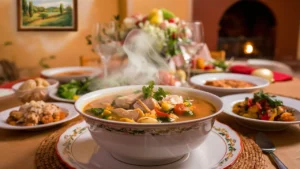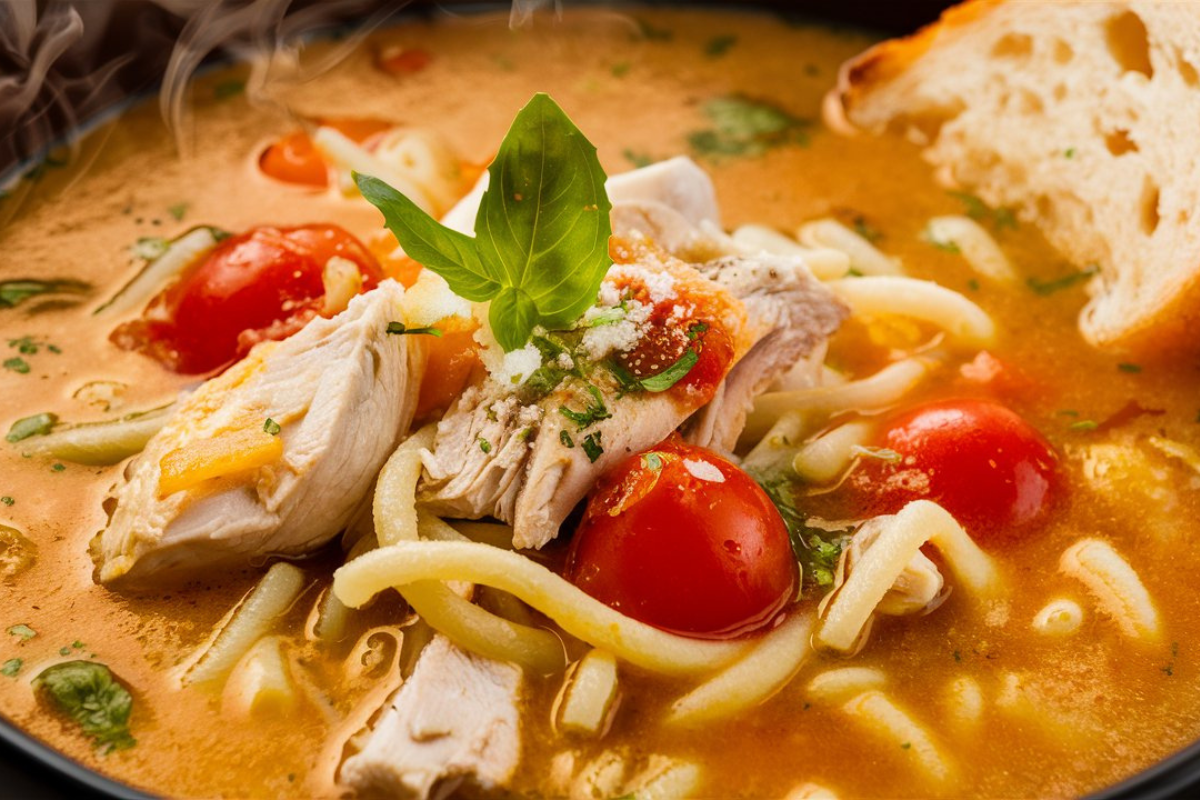When it comes to comforting, healing, and delicious soups, Italian Penicillin Soup is a standout. Known as a traditional Italian soup, this dish is renowned for its immune-boosting properties and often referred to as “Penicillin” due to its reputation for fighting off colds and flu. This comprehensive guide delves into everything you need to know about Italian Penicillin Soup—from its rich history and origins, key ingredients, and health benefits, to traditional recipes, modern adaptations, cooking tips, and frequently asked questions. Let’s dive into the warm and flavorful world of Italian Penicillin Soup, also celebrated as a healing Italian chicken soup and an immune-boosting Italian soup, often recognized as an Italian cold remedy soup.
Introduction
Italian Penicillin Soup, often dubbed the magical elixir for its healing properties, offers more than just comfort food. This soup, deeply rooted in Italian culinary tradition, combines simple ingredients that pack a powerful punch. People celebrate it not just for its taste, but for its ability to soothe the body and soul, especially during the cold season. As a traditional Italian soup, it’s also known as a healing Italian chicken soup and an immune-boosting Italian soup, often recognized as an Italian cold remedy soup. Similarly, comforting recipes like the Chick-fil-A Chocolate Chip Cookie Recipe provide a sense of warmth and satisfaction.”
History and Origins of Italian Penicillin Soup
The Roots of a Tradition
The history of Italian Penicillin Soup dates back centuries, intertwining with the rich tapestry of Italian cuisine. Traditionally, Italian grandmothers, or “nonnas,” made this soup using fresh, local ingredients that were readily available. For instance, the base of the soup is a flavorful chicken broth, simmered with aromatic herbs, garlic, and lemon—each ingredient chosen for its specific health benefits.
Why “Penicillin”?
The term “Penicillin” is not meant literally, of course. It nods to the soup’s reputation for warding off illnesses. Garlic, one of the key ingredients, provides antimicrobial properties, similar to how penicillin functions. Lemons, rich in vitamin C, and the soothing chicken broth, which hydrates and provides nutrients, make this soup a natural remedy for colds and flu. For more information on foods rich in vitamin C, refer to this comprehensive guide.
Italian Penicillin Soup is more than just a dish; it offers a comforting, therapeutic experience passed down through generations. Now, let’s explore the specific ingredients that make this soup so special and their respective health benefits.
Ingredients and Health Benefits
Key Ingredients of Italian Penicillin Soup
Italian Penicillin Soup is renowned for its simple yet powerful ingredients, each contributing to its healing properties. Here’s a closer look at what goes into this magical brew:
- Chicken Broth: The base of the soup, rich in minerals and nutrients, helps to hydrate and nourish the body.
- Garlic: Known for its immune-boosting and antimicrobial properties, garlic is a powerhouse ingredient.
- Lemon: Packed with vitamin C, lemon helps boost immunity and adds a refreshing zest.
- Fresh Herbs (Parsley, Oregano, Thyme): These herbs not only add flavor but also have various health benefits, including anti-inflammatory properties.
- Vegetables (Carrots, Celery, Onion): These veggies provide essential vitamins and minerals, making the soup hearty and nutritious.
- Pasta (Optional): While not essential, pasta can make the soup more filling and comforting.
Health Benefits of Italian Penicillin Soup
This soup isn’t just delicious; it’s a natural remedy packed with health benefits:
- Immune Support: Thanks to garlic and lemon, the soup is great for boosting the immune system.
- Hydration: The chicken broth helps keep you hydrated, which is crucial when you’re sick.
- Nutrient-Rich: Vegetables and herbs add a wealth of vitamins and minerals, supporting overall health.
- Anti-Inflammatory: Ingredients like garlic and herbs have anti-inflammatory properties that can help reduce symptoms of illness.
By incorporating these simple, natural ingredients, Italian Penicillin Soup serves as both a comforting meal and a natural remedy, perfect for those chilly days when you need a little extra care.
Stay tuned for Part 3, where we’ll dive into the traditional recipe for making Italian Penicillin Soup and explore some popular variations to suit different dietary preferences.
Traditional Recipe
Classic Italian Penicillin Soup Recipe
Cooking up a pot of Italian Penicillin Soup is like conjuring a bit of magic in your kitchen. This classic recipe captures the essence of Italian comfort food, offering both nourishment and delight. Follow these step-by-step instructions to create your own healing bowl of soup.
Ingredients
- 1 whole chicken or 4 bone-in chicken breasts
- 8 cups of chicken broth
- 1 large onion, chopped
- 3 cloves of garlic, minced
- 3 carrots, sliced
- 2 celery stalks, sliced
- Juice of 2 lemons
- 1 bunch of fresh parsley, chopped
- 1 tsp dried oregano
- 1 tsp dried thyme
- Salt and pepper to taste
- Optional: 1 cup of pasta (small shapes like ditalini or orzo)
Instructions
- Prepare the Chicken: In a large pot, place the chicken and cover with chicken broth. Bring it to a rolling boil, then lower the heat to maintain a gentle simmer. Cook until the chicken is tender and easily shredded, about 30-40 minutes.
- Sauté the Vegetables: While the chicken is cooking, heat a bit of olive oil in a large skillet. Add the chopped onion, minced garlic, sliced carrots, and celery. Sauté until the vegetables are softened, about 5-7 minutes.
- Combine and Simmer: Once the chicken is cooked, remove it from the pot and shred the meat, discarding the bones and skin. Return the shredded chicken to the pot. Add the sautéed vegetables, lemon juice, chopped parsley, oregano, and thyme. Simmer for another 15-20 minutes to let the flavors meld together.
- Add Pasta (Optional): If you’re including pasta, add it to the pot during the last 10 minutes of cooking. Make sure it’s cooked al dente to avoid mushiness.
- Season and Serve: Taste the soup and season with salt and pepper as needed. Ladle into bowls and serve hot, garnished with extra parsley if desired.
This traditional recipe is a true testament to the power of simple ingredients. It’s easy to see why Italian Penicillin Soup has been cherished for generations.
Variations of Italian Penicillin Soup

Cultural Significance and Modern Adaptations
Cultural Importance in Italy
In Italy, Italian Penicillin Soup is more than just a dish; it’s a cherished tradition. This soup embodies the essence of Italian home cooking—simple, nourishing, and made with love. Often, it’s the star of family gatherings, especially during colder months when its warming properties are most appreciated.
Regional Variations
Different regions in Italy have their own unique takes on this classic soup. In some areas, you’ll find it made with a richer broth, while others might add regional vegetables or specific types of pasta. This regional diversity highlights the adaptability of the soup and its deep-rooted significance in Italian culinary culture.
Modern Adaptations and Popularity
As the world becomes more health-conscious, the appeal of Italian Penicillin Soup has only grown. Today, it’s popular not just in Italy, but globally, as people seek out natural remedies and wholesome meals. Modern adaptations often focus on enhancing the nutritional value or catering to specific dietary requirements.
Contemporary Twists
- Superfood Additions: Some modern recipes incorporate superfoods like kale, quinoa, or turmeric to boost the soup’s health benefits.
- Instant Pot Version: For those with busy lifestyles, using an Instant Pot can significantly reduce cooking time while still delivering rich flavors.
- Bone Broth: Swapping regular chicken broth for nutrient-dense bone broth can enhance the healing properties of the soup.
By blending tradition with innovation, Italian Penicillin Soup continues to be a beloved dish that adapts to the times while retaining its comforting essence.
Stay tuned for Part 5, where we’ll share cooking tips and serving suggestions to make your Italian Penicillin Soup experience even more delightful.
Cooking Tips and Serving Suggestions
Cooking Tips for the Perfect Soup
Creating a perfect bowl of Italian Penicillin Soup isn’t just about following a recipe—it’s about adding your personal touch and understanding some key cooking tips. Therefore, here are some expert tips to ensure your soup turns out delicious every time:
- Quality Ingredients: First and foremost, start with the freshest ingredients possible. Fresh herbs, high-quality chicken, and organic vegetables will make a noticeable difference in flavor.
- Low and Slow: Simmering the soup slowly allows the flavors to develop fully. Consequently, don’t rush the process; let the broth gently extract all the goodness from the ingredients.
- Degrease the Broth: If you’re using a whole chicken, you might find some fat floating on the top as it cooks. Thus, skim off the excess fat for a cleaner, less greasy broth.
- Season Gradually: Add salt and other seasonings gradually. In fact, taste as you go to ensure the flavors are balanced. It’s easier to add more seasoning than to correct over-seasoning.
- Add Fresh Herbs Last: To preserve the bright, fresh flavors of herbs like parsley and thyme, add them at the end of cooking rather than at the beginning.
Serving Suggestions
How you serve your Italian Penicillin Soup can enhance the dining experience, making it even more comforting and enjoyable. Consider these serving suggestions:
- Garnishes: Fresh parsley, a squeeze of lemon, or a sprinkle of Parmesan cheese can add a delightful finishing touch to each bowl.
- Accompaniments: Serve the soup with a side of crusty bread or a simple green salad to complete the meal.
- Pairing: While we won’t delve into wine pairings, a nice herbal tea or a glass of sparkling water with lemon can be a perfect complement.
- Family Style: If you’re serving a group, consider placing the soup in a large pot at the center of the table, allowing everyone to help themselves. This communal style of eating is very much in line with the Italian tradition.
By following these tips and serving suggestions, you can elevate your Italian Penicillin Soup from a simple meal to a comforting and memorable dining experience.

Frequently Asked Questions
Curious minds often have questions about Italian Penicillin Soup. Therefore, here are some of the most frequently asked questions, answered to help you better understand and enjoy this wonderful dish
What is Italian Penicillin Soup?
Italian Penicillin Soup is a traditional Italian chicken soup known for its healing properties. It typically includes chicken broth, garlic, lemon, fresh herbs, and vegetables. People praise it for its immune-boosting benefits.
Why is pastina called Italian penicillin?
Pastina is called “Italian penicillin” because it is often used in simple soups that are believed to have healing properties, similar to the comforting and soothing effects of chicken soup. The small pasta is easy to digest and often used in broths that help to nourish and heal.
What is the most famous soup in Italy?
The most famous soup in Italy is probably Minestrone. This hearty vegetable soup, often containing beans, pasta, and a variety of seasonal vegetables, is a staple in Italian cuisine.
Did Barilla discontinue pastina?
Yes, Barilla announced that it discontinued pastina due to changes in production and demand. However, pastina can still be found from other brands or made at home.
What are the benefits of Pastina soup?
Pastina soup offers several benefits:
- Easy to Digest: The small pasta is gentle on the stomach.
- Comforting: The warmth and simplicity make it a comforting meal.
- Nourishing: Often made with broth and simple ingredients, it provides essential nutrients.
What are the health benefits of Italian Penicillin Soup?
- Garlic: Has antimicrobial properties.
- Lemon: Rich in vitamin C.
- Chicken Broth: Hydrating and nutrient-rich.
- Fresh Herbs: Anti-inflammatory and rich in antioxidants.
Can you make Italian Penicillin Soup vegetarian?
Yes, you can easily make a vegetarian version by substituting the chicken broth with vegetable broth and adding more vegetables for substance and flavor.
How long does Italian Penicillin Soup last in the fridge?
The soup can be stored in the fridge for up to 4-5 days. For longer storage, consider freezing it in portions.
Is Italian Penicillin Soup good for colds?
Conclusion
Italian Penicillin Soup is more than just a meal; it’s a tradition, a remedy, and a comfort all rolled into one. From its rich history and simple yet powerful ingredients to its health benefits and cultural significance, this soup embodies the best of Italian home cooking. Whether you’re making it to ward off a cold or simply to enjoy a delicious and nutritious meal, Italian Penicillin Soup is a dish that warms both the body and the soul. Give it a try, and let the magic of this Italian classic work its wonders in your kitchen.
